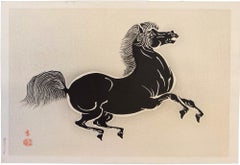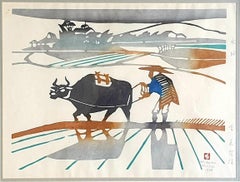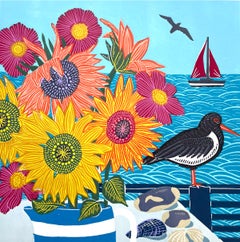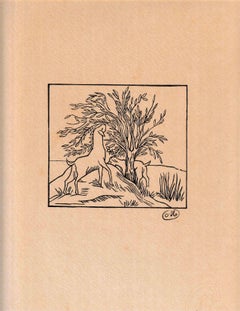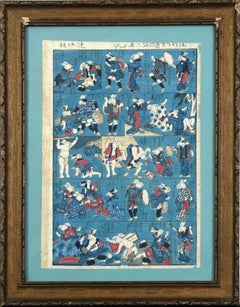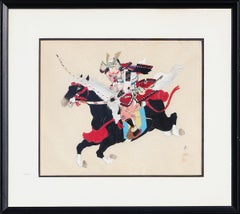Edo Animal Prints
to
1
1
Overall Width
to
Overall Height
to
2,002
1,404
399
279
211
154
116
79
39
37
33
13
12
8
1
2
2
2
1
1
1
1
1
1
2
1
1
1
1
1
1
Style: Edo
Black Horse
By Tokuriki Tomikichiro
Located in Middletown, NY
circa 1950.
Woodblock print in black and gray ink on Japon laid paper, 10 1/4 x 15 3/4 inches (260 x 398 mm), full margins. With the artist's embossed chop mark in red ink in the l...
Category
Mid-20th Century Edo Animal Prints
Materials
Handmade Paper, Woodcut
(創作版画 Mid-Century Japanese Coloured Woodblock Print. Ploughing the Fields.
Located in Cotignac, FR
Mid-Century coloured woodblock print of 'ploughing the fields' by 20th century Japanese artist Ini Kumo. The print is hand-signed in pencil, dated 1966 and numbered 130/700 to the bottom right and presented under glass in a black wooden frame.
A beautiful woodblock printed image of a Japanese farmer in traditional attire ploughing the land with his ox. It is early evening and as the sun goes down it casts long shadows in front of the two figures. Perhaps the farmer is on his way back to the houses grouped in the distance already in shadow. The artist has carefully picked out areas of vibrant green and blue to give energy and colour to the image which contrast against the black of the ox.
A thoroughly enchanting image.
Ini Kumo is a recognised Sõsaku-hanga artist. His work is included in the Metropolitan Museum of Art in New York.
Sōsaku-hanga (創作版画, "creative prints") was an art movement of woodblock printing which was conceived in early 20th-century Japan. It stressed the artist as the sole creator motivated by a desire for self-expression, and advocated principles of art that is "self-drawn" (自画 jiga), "self-carved" (自刻 jikoku) and "self-printed" (自摺 jizuri). As opposed to the parallel shin-hanga ("new prints") movement that maintained the traditional ukiyo-e collaborative system where the artist, carver, printer, and publisher engaged in division of labor.
The birth of the sōsaku-hanga movement was signaled by Kanae Yamamoto...
Category
Mid-20th Century Edo Animal Prints
Materials
Ink, Paper
Related Items
Seaside Flowers, Art print, Floral, Costal, Animal, Bird, Landscape
By Kate Heiss
Located in Deddington, GB
A bunch of cheery sunflowers arranged in a Cornish Ware jug sits pride of place on the window sill of this harbour cottage. A collection of beach finds fr...
Category
2010s Edo Animal Prints
Materials
Paper, Archival Ink
$213
H 15.75 in W 15.75 in D 0.4 in
Two Goats, from "Daphnis & Chloe"
Located in Middletown, NY
Woodcut on hand made laid paper with the publisher's watermark designed by the artist, full margins. From the special suite of 53 woodcut illustrations which were laid in loose to t...
Category
Mid-20th Century Edo Animal Prints
Materials
Handmade Paper, Laid Paper, Woodcut
Lines in Four Directions, Rubber Stamp Portfolio, Sol LeWitt
By Sol LeWitt
Located in Southampton, NY
Printer’s ink from rubber stamp on vélin d’Arches Satine paper. Paper Size: 8 x 8 inches. Inscription: Unsigned, as issued. Notes: From the folio, Rubber Stamp Portfolio, 1977. Publi...
Category
1970s Edo Animal Prints
Materials
Printer's Ink
$5,996 Sale Price
20% Off
H 8 in W 8 in
"The Engraver" Double Layer Woodblock Print
Located in Soquel, CA
Bold woodcut print by M. Sheppard (20th Century). This piece is filled with Neolithic imagery of people and animals. There are two figures that are engaged in hunting and several pre...
Category
1980s Edo Animal Prints
Materials
Paper, Ink, Woodcut
"Winter Wildfowling" Frank Weston Benson, Hunting Scene, Outdoors, Marshes
Located in New York, NY
Frank Weston Benson
Winter Wildfowling, 1927
Signed lower left
Etching on paper
Image 8 1/2 x 7 inches
Born in Salem, Massachusetts, a descendant of a long line of sea captains, Benson first studied art at Boston’s Museum School where he became editor of the student magazine. In 1883, Benson enrolled at the Académie Julian in Paris where artists such as Bouguereau, Lefebvre, Constant, Doucet and Boulanger taught students from all over Europe and America. It was Boulanger who gave Benson his highest commendation. “Young man,” he said, “Your career is in your hands . . . you will do very well.” Benson’s parents gave him a present of one thousand dollars a twenty-first birthday and told him to return home when it ran out. The money lasted long enough to provide Benson with two years of schooling in Paris, a summer at the seaside village of Concarneau in Brittany and travel in England.
Upon returning to America, Benson opened a studio on Salem’s Chestnut Street and began painting portraits of family and friends. An oil of his wife, Ellen Perry Peirson, dressed in her wedding gown is representative of this period. It demonstrates not only the academic techniques he learned at the Academie Julian but also his own growing emphasis on the effects of light. And yet, despite all the technical mastery displayed in the work, the painting exudes the warmth that existed between model and artist. More than a likeness, it is a study in serenity. Perhaps it was of a work such as this that Benson was thinking when he said, “The more a painter knows about his subject, the more he studies and understands it, the more the true nature of it is perceived by whoever looks at it, even though it is extremely subtle and not easy to see or understand. A painter must search deeply into the aspects of a subject, must know and understand it thoroughly before he can represent it well.”
Following a brief stint as an instructor at the Portland, Maine, Society of Art, Benson was appointed as instructor of antique drawing at the Museum School in Boston in the spring of l889. Benson’s long association with the school was particularly fruitful. Under the leadership of Edmund Tarbell and Benson the Museum School became a national and internationally recognized institution. The students won numerous prizes, enrollment tripled, a new school building was erected and visiting delegations from other schools sought the secret of their success. Benson cherished his role as teacher and was held in high esteem by his students, many of whom called him “Cher Maitre.” Reminiscing about his long career with the school Benson once said, “I may have taught many students, but it was I who learned the most.”
In 1890, Benson won the Hallgarten Prize at the National Academy in New York. It was the first of a long series of awards, that earning for him the sobriquet “America’s Most Medalled Painter.” In the early years of his career, Benson’s studio works were mostly portraits or paintings of figures set in richly appointed interiors. Young women in white stretch their hands out towards the glow of an unseen fire; girls converse on an antique settee in a room full of objets d’arts; his first daughter, Eleanor, poses with her cat. Works of this sort, together with a steady influx of portrait commissions, earned Benson both renown and financial rewards, yet it was in his outdoor works that gave Benson his greatest pleasure.
In the latter half of the 1890s, Benson summered in Newcastle, on New Hampshire’s short stretch of seacoast. It was here, in 1899, that Benson made his first foray into impressionism with Children in the Woods and The Sisters, the latter a sun-dappled study of his two youngest daughters, Sylvia and Elisabeth.
This painting was one of the first works that Benson hung at an exhibition with nine friends. The resignation of these ten illustrious artists rocked the American art establishment but, the catalogue for their first exhibition was titled, simply, “Ten American Painters.” When, in 1898, the three Bostonians and seven New Yorkers began to exhibit their best work in exquisitely arranged small shows, the group (dubbed by newspapers, “The Ten” ) quickly became known as the American Impressionists, a bow to the style of their French predecessors. The Ten’s annual shows soon became an eagerly awaited part of the annual exhibition calendar and were always well reviewed. Held annually in New York City, the group’s yearly exhibitions usually traveled to Boston and were occasionally seen in other cities. Benson’s association with other members of the group such as Childe Hassam, Thomas Dewing, William Merrit Chase and J. Alden Weir, only reinforced his growing emphasis on the tenets of Impressionism. As he later said to his daughter Eleanor, “I follow the light, where it comes from, where it goes.”
The principles of Impressionism began to dominate Benson’s work by 1901, the year that the Bensons first summered on the island of North Haven in Maine’s Penobscot Bay. His summer home “Wooster Farm,” which they rented and finally bought in 1906, became the setting for some of Benson’s best known work and there, it seemed, he found endless inspiration. Benson’s sparkling plein-air paintings of his children–Eleanor, George, Elisabeth and Sylvia–capture the very essence of summer and have been widely reproduced: In The Hilltop, George and Eleanor watch the sailboat races from the headland near their house.
As a boy, Benson dreamed of being an ornithological illustrator. In mid-life, he returned to the wildfowl and sporting subjects that had remained his lifelong passion. Using etching and lithography, watercolor, oil and wash, Benson portrayed the birds observed since childhood and captured scenes of his hunting and fishing expeditions.
Together with his two brothers-in-law, Benson bought a small hunting retreat on a hill overlooking Cape Cod’s Nauset Marsh. Here, in the late 1890s, he began experimenting with black and white wash drawings. These paintings became so popular that Benson was not able to keep up with the demand. He turned to an art publishing company to have several made into it intaglio prints; twelve wash drawings are known to have been reproduced in this manner. At least two of them were given as gifts to associate members of the Boston Guild of artists, of which Benson was a founding member.
Benson was also an avid fisherman and his salmon fishing expeditions to Canada’s Gaspé Peninsula where one of the high points of his summer. There, in 1921, he began the first in a series of watercolors that would eventually over 500 works.
Benson’s watercolors conveyed the joy and beauty of a sportsman’s life whether in a painting of a hunter setting out decoys, a flock of ducks coming in for a landing or a grouse flushed from cover. The critics favorably compared Benson’s watercolors to those of Homer. “The love of the almost primitive wilderness which appears in many of Homer’s landscapes and the swift, sure touch with which he suggests rather than describes–these also characterize Benson’s work,” one critic wrote. “The solitude of the northern woods is very much like Homer’s.”
Like the wash drawings before them, Benson’s watercolors proved...
Category
1920s Edo Animal Prints
Materials
Paper, Etching
Stag
Located in San Francisco, CA
This artwork titled "Stag" 1957 is an original woodcut on laid paper by noted American artist Leonard Baskin, 1922-2000. It is hand signed and inscribed A.P. (Artist Proof) pencil by...
Category
Mid-20th Century Edo Animal Prints
Materials
Woodcut
Proud Puffin, Art print, Floral, Costal, Animal, Bird, Landscape
By Kate Heiss
Located in Deddington, GB
A proud puffin sits on the cliff’s edge amongst the sea thrift and the ox-eye daisies. Linocut Limited Edition of 30 Printed with oil based relief inks on 300gsm soft white Somerset ...
Category
2010s Edo Animal Prints
Materials
Paper, Archival Ink
$213
H 15.75 in W 15.75 in D 0.4 in
Wassily Kandinsky - Composition - Woodcut
Located in Collonge Bellerive, Geneve, CH
Wassily Kandinsky - Composition - Original Woodcut
Condition: excellent
32 x 24 cm
1959
Published by XXe siècle, San Lazzaro
Printed signature (monogram) in the plate
Unnumbered as i...
Category
1960s Edo Animal Prints
Materials
Woodcut
Polish French Expressionist Judaica Woodcut Had Gadya from Passover Haggadah
Located in Surfside, FL
Arthur Kolnik, Jewish painter and printmaker Ivano-Frankivsk (Ukraine) 1890 - Paris (France) 1972
Arthur Kolnik was born in Stanislavov, a small town in Galicia, which was then part of the Austro-Hungarian Empire. His father, who was originally from Lithuania, worked as an accountant and his mother, who was originally from Vienna, ran a shop. In 1905, he discovered Yiddish literature in Czernowitz, on the occasion of the first conference on Yiddish language, which was organized by several writers including I. L. Peretz, Cholem Aleichem, Shalom Asch, and Nomberg.
In 1909, Kolnik joined the School of Fine Arts in Krakow and took classes taught by Jacek Malezcewski and Joseph Mehoffer, a portrait painter and an artist who produced stained-glass windows in Fribourg (Switzerland).
He was mobilized in the Austrian army in 1914. He was wounded in 1916 and repatriated to Vienna, where he met the Judaic painter Isidor Kaufmann. In 1919, Kolnik settled in Czernowitz, which was then annexed by Romania. There, he met writer and poet Itzik Manger and storyteller Eliezer Steinberg for whom he produced several illustrations. In 1920, Kolnik left for the United States, bringing fifty paintings...
Category
20th Century Edo Animal Prints
Materials
Woodcut
$1,000
H 21.25 in W 17 in
The Couple - Etching by Mino Maccari - 20th Century
By Mino Maccari
Located in Roma, IT
The Couple is an original etching realized by Mino Maccari in the mid-20th Century.
Good condition.
Mino Maccari (1898-1989) was an Italian writer, painter, engraver and journalist...
Category
20th Century Edo Animal Prints
Materials
Paper, Woodcut
$270
H 8.27 in W 6.3 in D 0.08 in
Latin American Judaica Conceptual Chassidic Art Modern Woodcut Luis Camnitzer
Located in Surfside, FL
Luis Camnitzer and Martin Buber (1878-1965),
New York: JMB Publishers Ltd, 1970.
Printed at The New York Graphic Workshop.
Hand signed on Arches paper. (Edition 24/100, numbered on Justification page)
Woodblock prints based on folktales from the Hasidic Jewish tradition in Eastern Europe, selected by Camnitzer from the early masters section of Buber’s Die chassidischen Bücher as translated by Olga Marx. German Expressionist style Jewish woodcuts...
Category
1970s Edo Animal Prints
Materials
Woodcut
$1,100
H 25.5 in W 20.5 in
Bear with Predella, Rubber Stamp Portfolio, Don Nice
By Don Nice
Located in Southampton, NY
Printer’s ink from rubber stamp on vélin d’Arches Satine paper. Paper Size: 8 x 8 inches. Inscription: Unsigned, as issued. Notes: From the folio, Rubber Stamp Portfolio, 1977. Publi...
Category
1970s Edo Animal Prints
Materials
Printer's Ink
$956 Sale Price
20% Off
H 8 in W 8 in
Previously Available Items
Comical Ukiyo-e Print with Anthropomorphic Rabbits
Located in Soquel, CA
Comical Ukiyo-e Print with Anthropomorphic Rabbits
This colorful Ukiyo-e print features anthropomorphic rabbits interacting in a variety of social situations, such as eating meals t...
Category
19th Century Edo Animal Prints
Materials
Woodcut, Ink
Hand Painted Print on Silk of a Mounted Samurai Warrior on Horseback with Bow
Located in Houston, TX
Hand painted print on silk of a mounted samurai warrior armed with a yumi style longbow. The work features a Japanese samurai wearing a kuwagata style helmet riding a black horse wit...
Category
20th Century Edo Animal Prints
Materials
Silk, Acrylic, Woodcut
H 20.63 in W 23.13 in D 0.75 in
Hand Painted Print on Silk of a Mounted Samurai Warrior on Horseback with Sword
Located in Houston, TX
Hand painted print on silk of a mounted samurai warrior armed with a katana sword. The work features a Japanese samurai wearing a kuwagata style helmet ri...
Category
20th Century Edo Animal Prints
Materials
Silk, Acrylic, Woodcut
H 20.63 in W 23.13 in D 0.75 in
Oban Yoko-e Hirame & Mebaru Fish with Cherry Blossoms, from the series Uozukushi
Located in Houston, TX
Beautiful print of Utagawa Hiroshige's "Hirame & Mebaru Fish with Cherry Blossoms" from his famous ukiyo-e Japanese woodblock series Uozukushi in which he endeavored to depict every ...
Category
20th Century Edo Animal Prints
Materials
Woodcut
Kurodai & Kodai Fish with Bamboo Shoots and Berries, from the series Uozukushi
Located in Houston, TX
Beautiful print of Utagawa Hiroshige's "Kurodai & Kodai Fish with Bamboo Shoots and Berries" from his famous ukiyo-e Japanese woodblock series Uozukushi i...
Category
20th Century Edo Animal Prints
Materials
Woodcut
Princess Wakana and Spider Magic Triptych Japanese Print
Located in Burbank, CA
The Tale of Shiranui (Shiranui Monogatari) was an epic illustrated gôkan comic book that was published between 1849 and 1855. The tale revolves around the clash between the Kikuchi and Ôtomo clans. Princess Wakana is given the power of spider magic by the Spirit of the Earth Spider. Here she is shown unfurling the magic scroll that conjures the spirit of the Earth Spider. The panel at left reads “Transformation of Princess Wakana”, and the other cartouches read “Washi-zu Roku-rô”, “Washi-zu Shichi-rô” and “Genk-kai nada Uemon” (left to right). Original first edition Japanese color woodblock print triptych...
Category
1850s Edo Animal Prints
Materials
Mulberry Paper, Woodcut
Edo animal prints for sale on 1stDibs.
Find a wide variety of authentic Edo animal prints available for sale on 1stDibs. Works in this style were very popular during the 20th Century, but contemporary artists have continued to produce works inspired by this movement. Frequently made by artists working with Acrylic Paint, and Fabric and other materials, all of these pieces for sale are unique and have attracted attention over the years. Not every interior allows for large Edo animal prints, so small editions measuring 23.13 inches across are also available. Prices for animal prints made by famous or emerging artists can differ depending on medium, time period and other attributes. On 1stDibs, the price for these items starts at $395 and tops out at $395, while the average work sells for $395.
Recently Viewed
View AllMore Ways To Browse
Pheasant Engraving
Picasso Dove Of Peace
Picasso Le Taureau
Picasso Rooster
Ronald Smith
Rooster Print Picasso
Salvador Dali Argus
Salvador Dali Unicorn
Sam Savitt
Shore Bird Print
Space Elephant Dali
Szabolcs Bozo
The Toad Picasso
Vintage Forest Service Posters
Vintage Posters Coppertone
Warhol Siberian Tiger
Warhol Zebra
Wild Turkey Audubon
